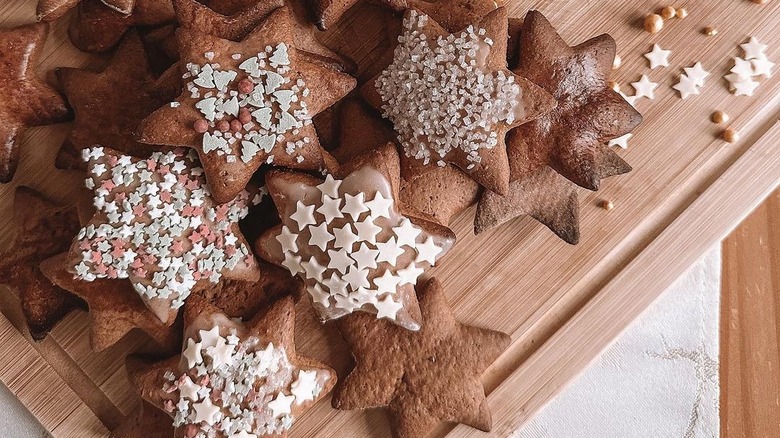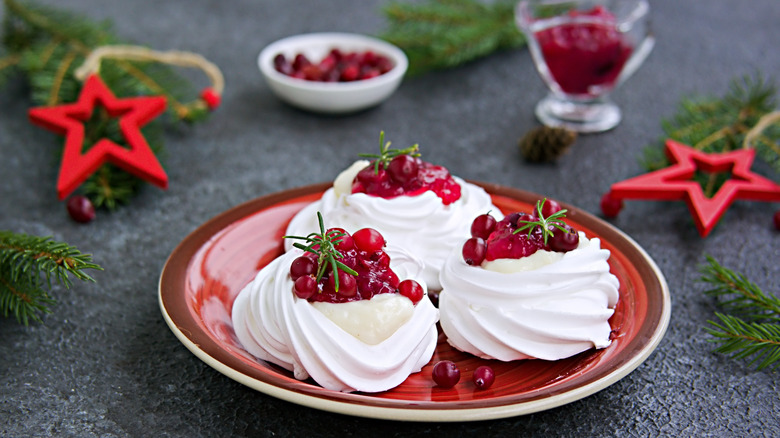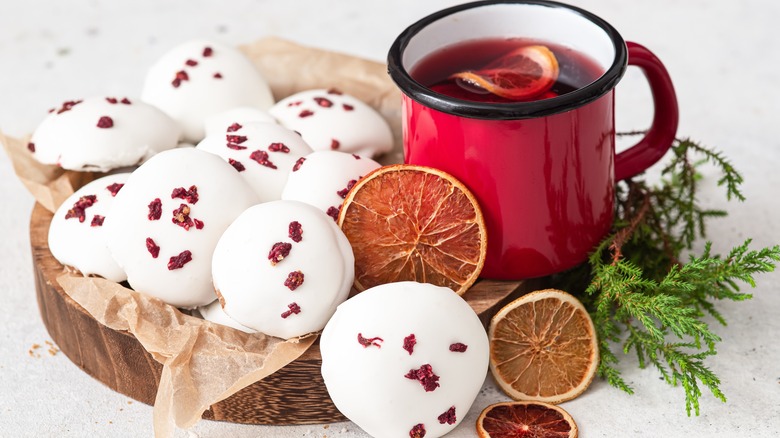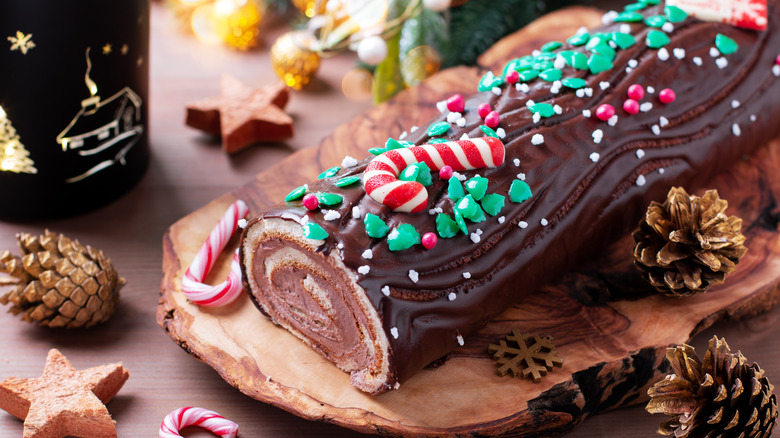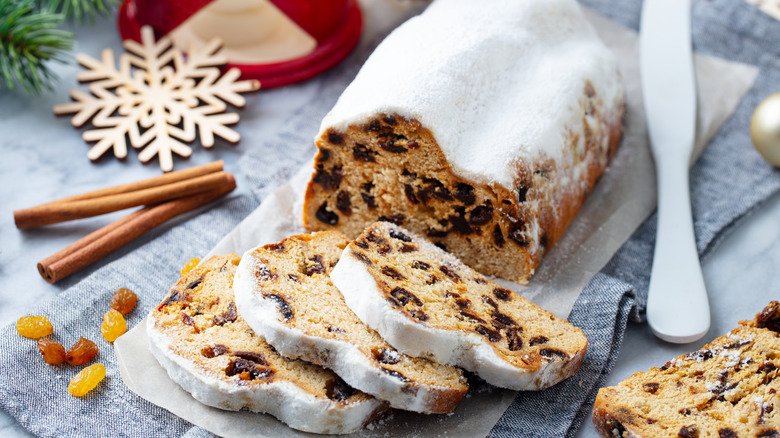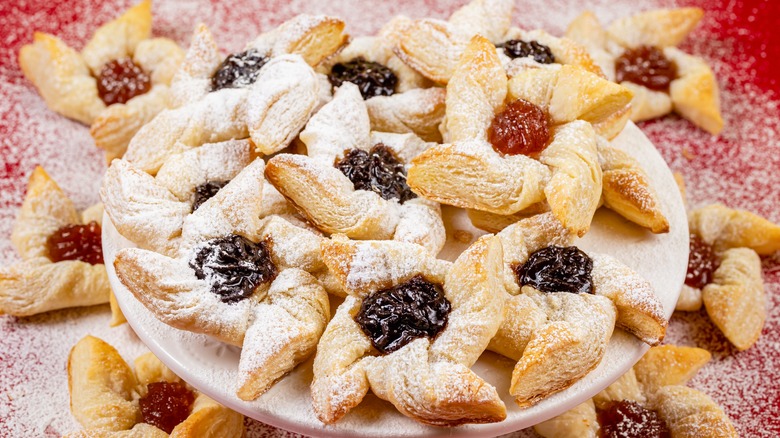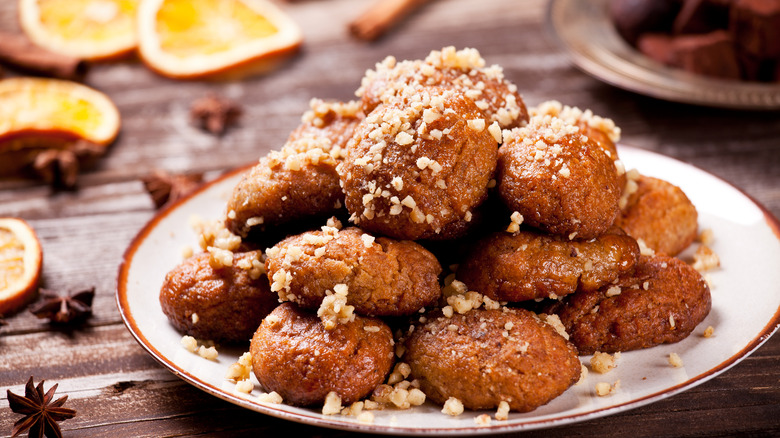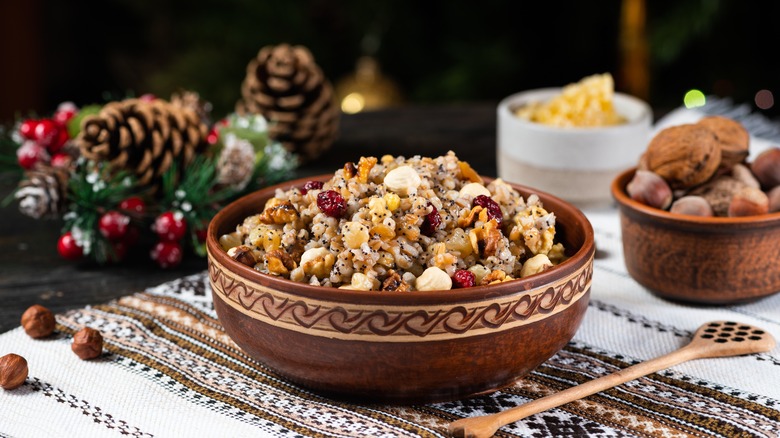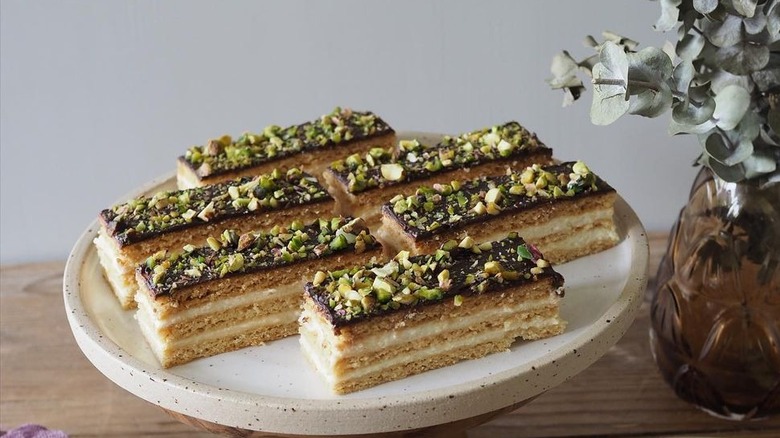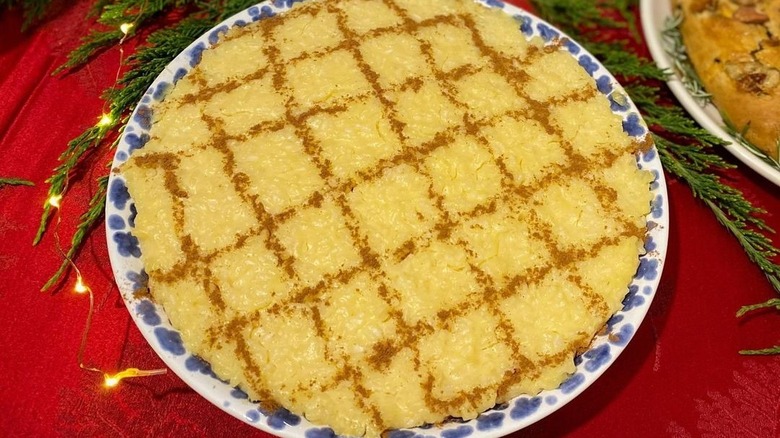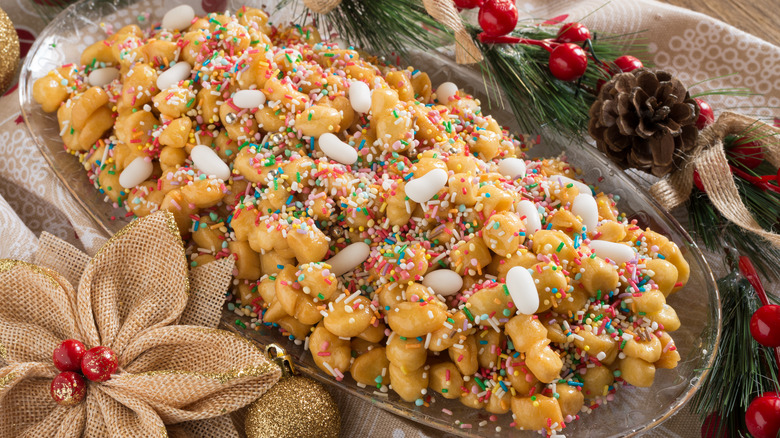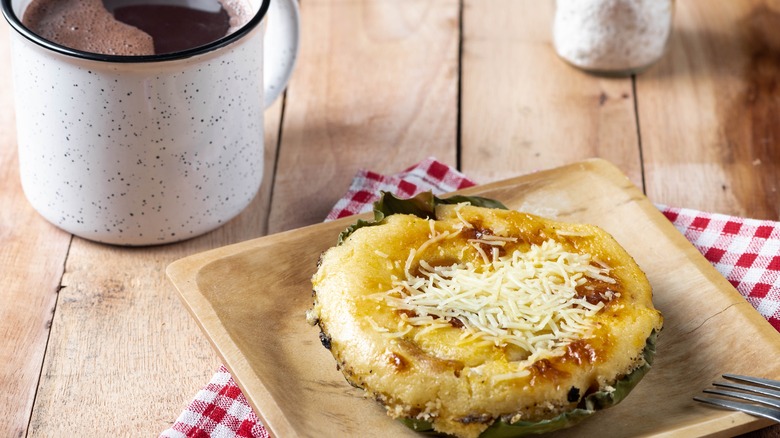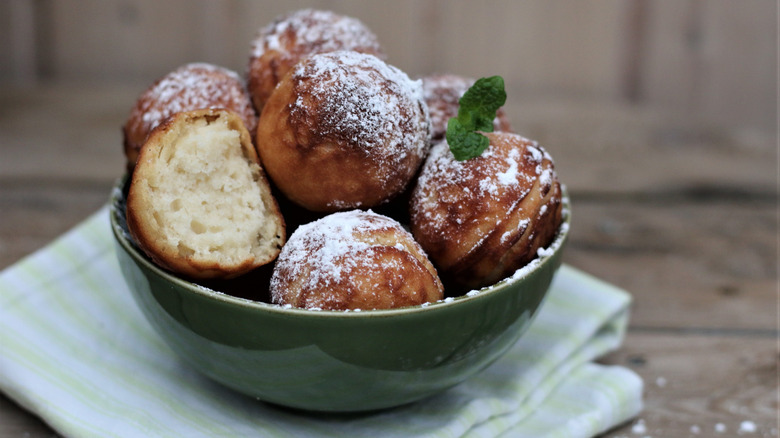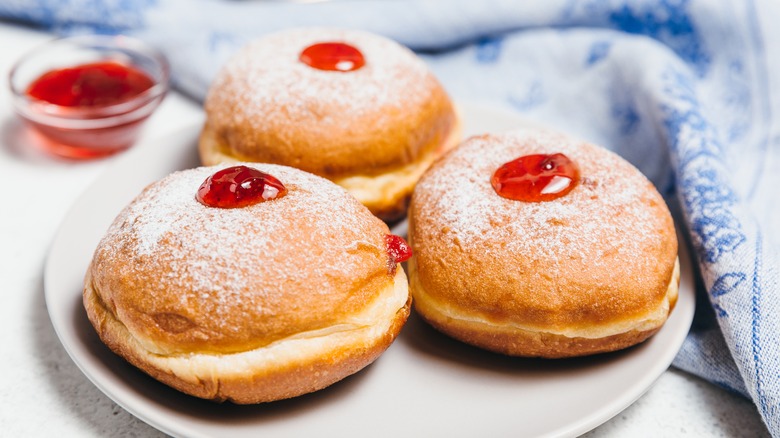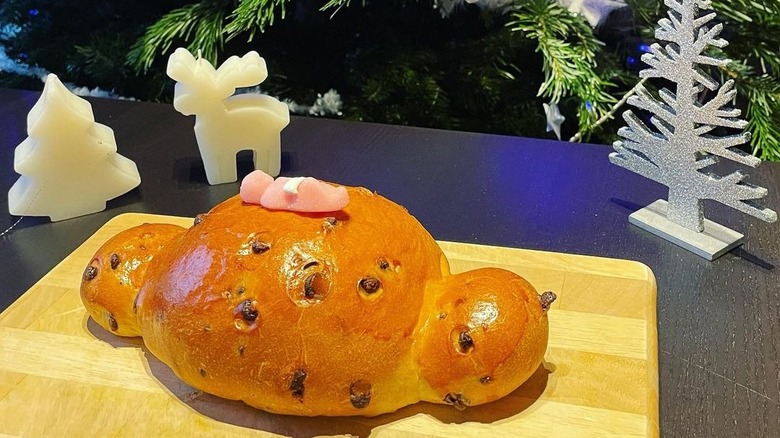15 Unique Holiday Desserts From Around The World
There's nothing better than all the scrumptious desserts during the holiday season, which isn't surprising given that decadent sweets have been part of holiday traditions for centuries, according to The Advocate. Countries all over the world have their own unique holiday desserts to celebrate the season, each with a special component that tells us something about that country or region's culture. Different ingredients, preparations, and traditions surrounding food can tell us a lot about the culture from which a specific food or recipe hails.
In many ways, there's no better way to learn about another culture than to eat their food, so we've rounded up 15 unique holiday desserts from around the world that you can try for yourself this holiday season. Who knows, you may just find your new favorite holiday dessert or put another region on your travel bucket list. Regardless, you're certain to try some delicious new ways to celebrate the holiday season.
Polish pierniczki świąteczne are quick and easy
If there's one dessert that's synonymous with Christmas, it has to be the Christmas cookie. If you want something a little different (but still quick and easy) to make for this year's holiday cookie exchange, take a note from the Poles. While certainly not the only Polish Christmas cookie option, pierniczki świąteczne are Polish Christmas cookies, whose name literally translates to Christmas gingerbreads. What's great about these treats is that they don't require you to refrigerate the dough, so they can be made lickety-split and without much fuss.
Bintu from Recipes from a Pantry shared a pierniczki świąteczne recipe from the Polish cookbook "Wild Honey and Rye" by Ren Behan, along with her own tips after baking the cookies multiple times, including how to string them up as tree decorations, what thickness to roll the dough, and even a good ratio of rye and plain flour to make your pierniczki świąteczne baking as easy and smooth as possible.
Pavlova is preferred in Australia and New Zealand
While the northern hemisphere celebrates the holidays in the winter months, making super heavy desserts the norm, the southern hemisphere celebrates in the middle of summer. This is likely the reason the go-to holiday dessert in Australia and New Zealand is pavlova. According to the BBC, the pavlova is named for Russian ballerina Anna Pavlova and there's a friendly feud between Australians and New Zealanders over who is to thank for the light and airy dessert. Regardless of who named it or made it first, we can all agree that this fruit and meringue dessert is delicious at the holidays, whether you're sporting snow boots or sandals.
This pavlova recipe from Mashed and chef/recipe developer Tara Rylie is easy enough for beginners and offers the important reminder that patience is key to a beautiful, airy pavlova. Whether you choose to top yours with summer berries, like strawberries and raspberries, or opt for something more seasonal in the northern hemisphere, such as cranberries, the beautiful and festive pavlova will make your holiday dessert spread look quite impressive.
In Germany you'll find spiced pfeffernüsse cookies
When you think of holiday spices, you likely think of clove, allspice, cinnamon, nutmeg, and ginger, but do you also think of pepper? If you're German, you probably do! Pfeffernüsse are traditional German Christmas cookies that contain pfeffer, which is the German word for pepper. According to National Today, pfeffernüsse have been most closely associated with Saint Nicholas Day and Christmas ever since the recipe was thought to have been created in the 1750s (National Pfeffernüsse Day is celebrated on December 23 each year). They're spicy and somewhat reminiscent of gingerbread, while having a unique flavor from the pepper that will make them super memorable at your holiday table.
The Fresh Cooky shared her family pfeffernüsse cookie recipe from her German paternal grandmother who was born in the 1800s, so this is an authentic recipe that has stood the test of time. While her recipe finds the cookies topped with powdered sugar, other versions have them coated in a powdered sugar glaze (likely a regional variation that we're certain is delicious either way).
Christmas Eve in France is bound to have bûche de Noël
Rather than tossing a yule log on the fire this holiday season, take a cue from the French and prepare a bûche de Noël, or Yule log cake, for your Christmas Eve celebration. Though Yule log cakes ostensibly celebrate Yule and honor ancient Nordic traditions, according to Atlas Obscura, the first published recipe for the cake is from 1895 by a French pastry chef, which helps explain why it's such a strong tradition in France.
Traditionally the bûche de Noël is made with genoise sponge, filled with buttercream, and covered in chocolate and forest-themed decorations, but feel free to let your creativity flow when you make your own. If you've never made one, the steps can be daunting, so you can also modify the ingredients to make it a little simpler. This Yule log cake recipe from Mashed and Laura Sampson opts for a whipped cream filling and store bought frosting, for instance. For a different flavor experience, try this bûche de Noël made from chocolate cake and topped with white chocolate. Whatever way you roll it, this complicated-looking dessert will be a star at your holiday party.
Christmas stollen is another German favorite
If you're looking for a dessert that can trace its roots back to the 1400s, German Christmas stollen — also called Christstollen, among other names — is the dessert for you. According to What's Cooking America, Christstollen tasted quite different during its early origins (due to the use of butter being forbidden during Advent at the time). Luckily for all of us, Prince Ernst von Sachsen was able to successfully petition the church to allow the use of butter during Advent (though only in the city of Dresden), leading to a much more delicious Christstollen that has persisted pretty much unchanged through the years. This is also why Dresden is the location most closely associated with the Christstollen.
So, what is it exactly? While a true Dresdner Christstollen is only produced in Dresden, a version of the sweet, fruit-filled, yeasted bread coated in powdered sugar (historically done to resemble the swaddled baby Jesus) can be made right at home. The Daring Gourmet's version of the Christstollen contains raisins, candied lemon peel, nuts, and homemade marzipan, though you can certainly buy your marzipan (and your candied citrus peel) if you're not up for making it. Though it isn't exactly a quick holiday dessert, it's worth it.
Joulutorttu in Finland are flaky and jammy
According to Finnish legend, Santa Claus (called Joulupukki, or Yule Goat) actually lives in the northern part of Finland, so you can imagine that Christmas and the whole holiday season is kind of a big deal there. The University of Oulu calls Joulutorttu one of the most iconic pastries of Finnish Christmas, and its name also refers to the Scandinavian celebration of Yule. The unique pastries are sometimes called Finnish Christmas stars, referring to the shape of the final product, achieved by folding over every other cut corner of a square of pastry dough around the sticky, jam-filled center.
Not only is it iconic, it's super easy to make. A Joulutorttu recipe from Curious Cuisinière lists just three ingredients for the crust — ricotta cheese, butter, and flour — while the filling is traditionally prune jam. Still, you definitely don't have to limit yourself to prune jam if it isn't, well, your jam. You can try berry jam, apple cinnamon filling, or whatever strikes your fancy, then dust it with powdered sugar to please Joulupukki.
Warm spices make the Greek melomakarona great for the holidays
Like in many cultures, the Greek celebration of Christmas involves a lot of food, much of which is of the dessert variety. Melomakarona, or Greek honey cookies, are a traditional Christmas dessert that, according to My Greek Dish, were originally served in the lead up to the holiday. Because they're so soft, sweet, and decadent, you may be surprised to learn that they have no egg or dairy in them, but this also ensures that Orthodox Christians can enjoy them during the Lenten period. While they do sometimes contain the unique ingredient
semolina to allow the cookies to absorb more of the honey syrup they are dunked in, if you can't find semolina, have no fear. Not all melomakarona recipes contain semolina.
This one from The Mediterranean Dish just uses plain flour and simple ingredients you probably already have or can easily obtain. Still, there is a trick to making melomakarona that everyone seems to agree on: The syrup needs to be made before the dough, so that the piping hot cookies can be dipped in the cooled honey syrup for maximum absorption (and maximum deliciousness).
In Eastern Europe and the Middle East, wheat berry pudding is traditional
When you think of holiday desserts, you may not immediately think of wheat berries, but wheat berry pudding in various forms is enjoyed in several different cultures during the holiday season. According to Little Sunny Kitchen, Middle Eastern Christians celebrate Saint Barbara's Day on December 4th, to kick off the countdown to Christmas, by eating Burbara, a porridge-like wheat berry dessert with dried fruit, cinnamon, sugar, and lots of black licorice flavors (including star anise, ground anise, and fennel seeds).
Eastern Europeans, on the other hand, eat their wheat berry pudding (called kutia or kutya) on Christmas Eve. In this recipe for kutia from Punchfork (via Natasha's Kitchen), honey, dried fruit, nuts, and poppy seeds are the star ingredients (alongside the wheat berries, of course), making for a very different flavor profile from the Middle Eastern Burbara, showcasing how different cultures bring unique flavors and traditions to otherwise similar dishes.
Slovakian honey petit fours are called medové rezy
For many, the holidays are all about large dessert spreads with many, bite-sized desserts. While that often takes the form of holiday cookies, Slovaks include their version of petit fours on their holiday tables. One popular version at the holidays is medové rezy, or honey cake slices. While making medové rezy seems pretty straightforward, Happy Foods Tube recommends dividing the prep across two or even three days, so making these honey cake slices takes commitment.
Medové rezy consists of thinly layered honey cake, a pudding filling, and jam (which can be made and assembled on day one of your two-day prep), and a chocolate glaze, which happens on the second day after the cakes have chilled. Once the chocolate glaze has set, and any toppings like nuts have been added, the medové rezy are sliced and ready to serve. Though, the longer they hang out in the fridge, the more the flavors of the pudding filling will mix the with honey cake and also give the layers some moisture, so don't be afraid to make them ahead of time.
In Portugal you'll find plenty of arroz doce
Some holiday desserts are made only during the holiday season, while others are incredibly popular year round. Portuguese arroz doce is one of the latter desserts, a sweet rice pudding that is served (and loved) year round, but is especially popular on Christmas Eve. Arroz doce is made with just a few ingredients: rice, milk, eggs, sugar, salt, vanilla, cinnamon, and lemon).
Some recipes, like this one from Tia Maria's Blog, call for the rice to be cooked with a cinnamon stick and lemon peel, while recipes like the one from Home Made Interest have you prepare the rice according to the package directions and add cinnamon and lemon peel later. Another difference between recipes is whether to simmer the cooked rice with just milk and add tempered egg yolks afterward, or whether to temper the egg yolks with the milk and then simmer the rice in that mixture.
These small differences in preparation method likely mean a lot to the recipe creators, but if you're making arroz doce for the first time, we advise you to pick one and go with it. At the end of the day, you end up with sweet, cinnamon-spiced rice pudding no matter which preparation you choose. Traditionally, it is decorated with a lattice patterned dusting of cinnamon and is delicious served both hot and cold.
There's lots of sweet, sticky struffoli in Italy
If you're looking to add a taste of Italy to your holiday celebration, there's no better way than to contribute traditional Italian struffoli to the dessert table. Delicious little balls of deep fried dough, piled into a dome or sometimes even a wreath shape, and topped with honey, sugar, and sprinkles, the sticky-sweet dessert is certain to be a crowd-pleaser (and maybe a bit messy, too).
Like some other Italian desserts, struffoli is traditionally flavored with anise, which you'll recognize as having a black licorice type flavor. According to Nonna Box, Neopolitan anise liquor is the most authentic for struffoli, but is hard to find. If that black licorice flavor isn't really your thing, use something else or leave it out entirely! This struffoli recipe from Tasting Table and recipe developer Stephanie Rapone uses Grand Marnier instead, but is still plenty Italian and plenty delicious.
In the Philippines they celebrate with early morning bibingka
While the holiday season can mean sleeping in and relaxing when there's no school and no work, for some it's about waking up before dawn and getting an early start on holiday cooking and baking. Among those early risers are many Filipinos who celebrate the holidays with what Bria asserts is the longest Christmas celebration in the world. For Filipinos, the lead up to Christmas proper begins months ahead of time in September, and the religious observance includes nine days' worth of Catholic mass at the break of dawn.
The best motivator for getting up that early (or for just about anything, for that matter) is food, and in the Philippines that food is fresh bibingka, or Christmas rice cakes, served during or after the early morning mass. As noted by Tasting Table, there are several different ways to prepare bibingka, and it can be topped with savory or sweet ingredients (or both!). Some common toppings for this morning dessert, according to SBS, are soft cheese and a sliced salted duck egg, or butter, granulated sugar, and grated coconut.
Aebleskiver is a special treat all holiday season in Denmark
While most of the desserts on this list are easy to make with equipment you already have at home, traditional Danish aebleskiver (which are essentially pancake balls or puffs) require a special aebleskiver pan — so, you're going to have to put in some work if you want to make this unique holiday dessert. According to the Ministry of Foreign Affairs of Denmark, aebleskiver (which translates to "apple slices") are one of the most popular Danish Christmas desserts and were originally filled with apple or applesauce. Today aebleskiver aren't usually filled with anything. Instead, they're served with jam or dipped in sugar, according to My Danish Kitchen.
Aside from the required special pan for cooking (and the knitting needle that My Danish Kitchen says is the traditional way to turn the puffs as they cook), aebleskiver are pretty straightforward to make with easily obtained ingredients. Luckily, once you have your pan and become a pro at making aebleskiver for the holidays, you can use the pan to make a whole assortment of dome-shaped street foods from around the world, including falafel, rösti, takoyaki, and so much more. You might even start to wonder how you ever lived without an aebleskiver pan, during the holidays or any time of year.
Sufganiyot is a Hanukkah favorite in Israel
While there are several foods traditionally associated with Hanukkah in the United States, according to Jewish Action, the most popular Hanukkah food in Israel is sufganiyot. As told by an Israeli folktale, these jelly donuts were fed to Adam and Eve by God to cheer them up after they were kicked out of the Garden of Eden. These days, their association with Hanukkah is due in part to being fried in oil, symbolic of the miracle of Hanukkah, in which a small amount of oil allowed the menorah of the Temple of Jerusalem to stay lit for eight days (via NPR).
Israel's largest bakery chain makes a whopping 25,000 sufganiyot a day during Hanukkah, and that's not counting all the other bakeries that also make their own. If you're so inclined, though, you can also make them at home with a little patience, the right ingredients, and a solid technique like the one outlined in this recipe for traditional strawberry sufganiyot from Bon Appétit.
Christmas sweet bread called cougnou is popular in Belgium
For Christians, the holiday season is a time of celebrating the birth of baby Jesus, so it's no wonder that some holiday desserts pay homage to this important moment. According to Atlas Obscura, cougnou — a unique type of sweet brioche in the shape of a swaddled baby — is one such dessert often made in Belgium, France, and other nearby countries during the Christmas season. It's typically a long loaf of bread with a ball of bread at each end to look like a swaddled baby, though sometimes a baby made of sugar or marzipan is placed on top of the bread to make the loaf appear as a cradle or the manger in which Jesus was laid.
Not your average brioche, cougnou has added sweets like dried fruit, chocolate chips, or pearl sugar as a filling. This recipe from Meilleur du Chef includes variations for all of the above (and even a few additional ideas) for whatever sweet cougnou suits you best. It also utilizes a special mold called a cougnou ring for a very finished look that isn't strictly necessary for the average holiday celebration, but certainly adds a nice touch.

